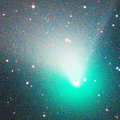
|
Now it is very bright as 6.6 mag (Jan. 11, Osamu Miyazaki). It will approach to Earth down to 0.29 a.u. in February, and it brightens up to 5 mag. In the Northern Hemisphere, it stays observable in excellent condition for a long time. In the Southern Hemisphere, it is not observable until early February.
Date(TT) R.A. (2000) Decl. Delta r Elong. m1 Best Time(A, h)
Jan. 14 15 46.74 40 8.8 0.672 1.112 82 6.6 5:38 (249, 59)
Jan. 21 15 32.70 51 13.9 0.479 1.120 93 5.9 5:37 (224, 64)
|

|
Now it is very bright as 8.1 mag (Jan. 9, Chris Wyatt). It is observable at 8 mag for a long time from 2022 to 2023. In the Southern Hemisphere, it stays observable for a long time, although it became low temporarily from November to December. In the Northern Hemisphere, it is not observable until summer.
Date(TT) R.A. (2000) Decl. Delta r Elong. m1 Best Time(A, h)
Jan. 14 20 9.14 -69 11.6 2.332 1.826 47 7.8 18:39 ( 25,-32)
Jan. 21 21 7.00 -70 30.4 2.295 1.844 51 7.8 18:45 ( 23,-31)
|
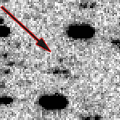
|
It will approach to Sun down to 0.1 a.u. on Jan. 31. In the Northern Hemisphere, it will appear in the morning sky at 9 mag in mid February, then it stays observable while the comet will be fading. In the Southern Hemisphere, it stays observable for a long time, although it is not observable from mid January to mid February.
Date(TT) R.A. (2000) Decl. Delta r Elong. m1 Best Time(A, h)
Jan. 14 20 35.34 -38 20.7 1.429 0.615 20 10.9 18:39 ( 55,-17)
Jan. 21 21 0.68 -33 56.0 1.227 0.418 17 8.6 18:45 ( 60,-16)
|
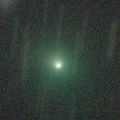
|
It brightened very rapidly. Now it is very bright as 9.6 mag (Jan. 2, Yoshimi Nagai). It stays 9-10 mag until March. In the Northern Hemisphere, it will be observable in good condition after this. In the Southern Hemisphere, it is not observable until June.
Date(TT) R.A. (2000) Decl. Delta r Elong. m1 Best Time(A, h)
Jan. 14 17 4.52 55 15.3 1.616 1.795 83 9.6 5:38 (224, 46)
Jan. 21 18 3.59 57 43.4 1.617 1.774 82 9.5 5:37 (221, 41)
|
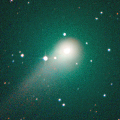
|
Now it is 9.8 mag (Dec. 27, Carlos Labordena). It stays bright as 10 mag for a long time until autumn. In the Northern Hemisphere, it stays observable in good condition until autumn. In the Southern Hemipshere, it stays unobservable until summer.
Date(TT) R.A. (2000) Decl. Delta r Elong. m1 Best Time(A, h)
Jan. 14 1 32.95 70 21.5 2.080 2.581 109 9.7 18:39 (174, 54)
Jan. 21 1 28.53 64 46.5 2.122 2.543 103 9.7 18:45 (164, 58)
|
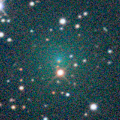
|
It brightened very rapidly. Now it is very bright as 11.5 mag (Jan. 10, Katsumi Yoshimoto). It stays 11-12 mag until February. In the Northern Hemisphere, it stays observable in excellent condition. In the Southern Hemisphere, it is not observable until February.
Date(TT) R.A. (2000) Decl. Delta r Elong. m1 Best Time(A, h)
Jan. 14 1 24.20 75 48.1 0.620 1.328 109 11.4 18:39 (176, 49)
Jan. 21 3 12.33 68 55.7 0.580 1.332 114 11.3 19:17 (180, 57)
|

|
It brightened up to 8.3 mag in last winter (Jan. 6, 2022, Toshiyuki Takahashi). Now it is fading. But it is bright as 11.1 mag still now (Jan. 2, Osamu Miyazaki).
Date(TT) R.A. (2000) Decl. Delta r Elong. m1 Best Time(A, h)
Jan. 14 9 49.31 -32 37.1 4.294 4.831 117 11.4 2:18 ( 0, 22)
Jan. 21 9 45.04 -33 27.8 4.279 4.871 121 11.5 1:46 ( 0, 21)
|
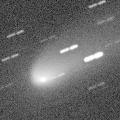
|
Now it is 11.7 mag (Dec. 26, Chris Wyatt). It stays 11-12 mag until spring.
Date(TT) R.A. (2000) Decl. Delta r Elong. m1 Best Time(A, h)
Jan. 14 15 7.01 -14 53.2 1.779 1.625 64 11.6 5:38 (326, 33)
Jan. 21 15 25.34 -15 53.7 1.743 1.639 67 11.6 5:37 (328, 33)
|

|
Now it is 13.2 mag (Nov. 27, Ken-ichi Kadota). It is expected to brighten up to 11 mag in 2023. In the Southern Hemisphere, it stays observable in good condition for a long time, although it becomes unobservable temporarily from November to January. In the Northern Hemisphere, it is not observable until 2024 autumn.
Date(TT) R.A. (2000) Decl. Delta r Elong. m1 Best Time(A, h)
Jan. 14 18 39.22 -27 21.9 4.212 3.272 15 11.8 5:38 (297,-10)
Jan. 21 18 47.11 -28 31.6 4.152 3.250 20 11.7 5:37 (300, -7)
|
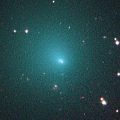
|
Now it is bright as 11.4 mag (Dec. 14, Jose Guilherme de S. Aguiar). It will be fading after this. In the Southern Hemisphere, it becomes unobservable temporarily from December to January. In the Northern Hemisphere, it is not observable until spring when it fades down to 15 mag.
Date(TT) R.A. (2000) Decl. Delta r Elong. m1 Best Time(A, h)
Jan. 14 19 26.64 -38 3.7 2.622 1.705 16 12.0 5:38 (301,-24)
Jan. 21 19 26.26 -38 6.9 2.626 1.738 20 12.3 5:37 (304,-19)
|
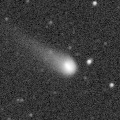
|
Now it is 12.4 mag (Dec. 18, Jose Guilherme de S. Aguiar). It stays 12 mag until summer. It stays observable in good condition for a long time.
Date(TT) R.A. (2000) Decl. Delta r Elong. m1 Best Time(A, h)
Jan. 14 13 47.33 2 35.1 3.565 3.687 89 12.5 5:38 (343, 56)
Jan. 21 13 43.49 2 2.6 3.424 3.676 96 12.4 5:37 (357, 57)
|
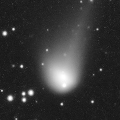
|
Now it is bright as 12.9 mag (Jan. 2, Hiroshi Abe). It stays 13 mag until spring. It stays observable in good condition for a while after this. It will be getting higher rapidly also in the Southern Hemisphere.
Date(TT) R.A. (2000) Decl. Delta r Elong. m1 Best Time(A, h)
Jan. 14 15 17.51 0 31.7 4.896 4.613 67 12.9 5:38 (312, 44)
Jan. 21 15 22.76 1 17.7 4.818 4.635 73 12.9 5:37 (318, 48)
|
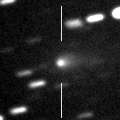
|
Now it is 12.7 mag (Jan. 2, Hiroshi Abe). It stays bright as 13 mag and observable in excellent condition until February.
Date(TT) R.A. (2000) Decl. Delta r Elong. m1 Best Time(A, h)
Jan. 14 8 40.35 10 37.6 0.919 1.879 161 12.9 1:10 ( 0, 65)
Jan. 21 8 36.70 11 54.6 0.917 1.894 169 13.0 0:39 ( 0, 67)
|
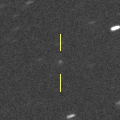
|
It brightens up to 13 mag in winter. But the condition is bad. It is not observable until February in the Southern Hemisphere, or until May in the Northern Hemisphere.
Date(TT) R.A. (2000) Decl. Delta r Elong. m1 Best Time(A, h)
Jan. 14 18 19.60 -25 47.1 2.489 1.591 18 13.4 5:38 (298, -5)
Jan. 21 18 43.19 -25 54.7 2.470 1.589 20 13.3 5:37 (299, -5)
|
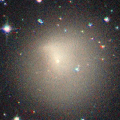
|
It brightened in major outburst in late November. Now it is very bright as 10.9 mag (Dec. 29, Martin Masek).
Date(TT) R.A. (2000) Decl. Delta r Elong. m1 Best Time(A, h)
Jan. 14 6 30.09 29 22.3 5.117 6.062 162 13.4 22:56 ( 0, 84)
Jan. 21 6 26.68 29 17.2 5.159 6.064 154 13.4 22:25 ( 0, 84)
|
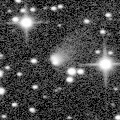
|
Now it is 13.9 mag (Jan. 13, P. Lindner). The brightness evolution is slower than originally predicted. It stays 14 mag until summer. In the Northern Hemisphere, it stays observable in good condition until spring. In the Southern Hemisphere, it stays observable in good condition for a long time.
Date(TT) R.A. (2000) Decl. Delta r Elong. m1 Best Time(A, h)
Jan. 14 3 21.40 -7 41.7 1.872 2.396 110 13.5 19:47 ( 0, 47)
Jan. 21 3 17.69 -9 38.3 1.941 2.354 102 13.5 19:16 ( 0, 45)
|
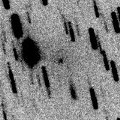
|
Tiny comet, but it will approach to Sun down to 0.8 a.u. in January, and to Earth down to 0.6 a.u. in March. It will brighten up to 14 mag from January to March. In the Southern Hemisphere, it stays observable in good condition for a long time. In the Northern Hemisphere, it is not observable now. It will become observable in early March. It has not been observed since late October.
Date(TT) R.A. (2000) Decl. Delta r Elong. m1 Best Time(A, h)
Jan. 14 21 42.43 -53 3.3 1.341 0.851 39 14.4 18:39 ( 35,-16)
Jan. 21 22 5.86 -56 23.1 1.245 0.838 42 14.2 18:45 ( 33,-19)
|
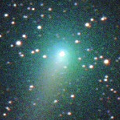
|
It brightened up to 9.3 mag in early summer (June 5, Chris Wyatt). Now it is fading. It has already faded down to 15.7 mag (Jan. 13, ATLAS South Africa). In the Southen Hemisphere, it stays observable in good condition for a long time. It became observable also in the Northern Hemisphere. But it stays locating low for a while.
Date(TT) R.A. (2000) Decl. Delta r Elong. m1 Best Time(A, h)
Jan. 14 8 3.54 -39 45.6 2.568 3.158 118 14.3 0:33 ( 0, 15)
Jan. 21 7 47.56 -37 40.2 2.590 3.222 122 14.4 23:44 ( 0, 17)
|
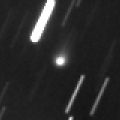
|
Now it is 14.7 mag (Jan. 13, ATLAS Chile). It stays 14 mag in 2023. In the Southern Hemisphere, it stays observable in good condition for a long time. It locates somewhat low in the Northern Hemisphere.
Date(TT) R.A. (2000) Decl. Delta r Elong. m1 Best Time(A, h)
Jan. 14 3 17.95 -19 40.9 3.105 3.474 103 14.4 19:43 ( 0, 35)
Jan. 21 3 7.48 -18 12.9 3.197 3.450 96 14.4 19:05 ( 0, 37)
|
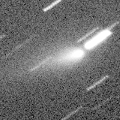
|
Outburst occured in early October, and it brightened up to 9.9 mag (Oct. 14, Thomas Lehmann). It is bright as 12.4 mag still now (Dec. 23, Ken-ichi Kadota). It stays observable only until February in the Southern Hemisphere, or until March in the Northern Hemisphere.
Date(TT) R.A. (2000) Decl. Delta r Elong. m1 Best Time(A, h)
Jan. 14 23 38.18 -10 52.2 2.358 2.013 57 14.6 18:39 ( 46, 32)
Jan. 21 23 51.83 -8 59.3 2.485 2.075 54 14.9 18:45 ( 52, 30)
|
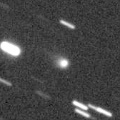
|
Now it is 14.8 mag (Dec. 26, Chris Wyatt). It is expected to brighten up to 8 mag in July. It will be getting lower after this. And it will be unobservable in February. In the Southern Hemisphere, it will be observable in excellent condition at the high light. In the Northern Hemisphere, it becomes very low at the high lihght.
Date(TT) R.A. (2000) Decl. Delta r Elong. m1 Best Time(A, h)
Jan. 14 0 28.55 -13 41.4 3.186 2.972 68 14.7 18:39 ( 32, 36)
Jan. 21 0 25.46 -13 32.1 3.247 2.902 61 14.7 18:45 ( 41, 31)
|

|
Now it is 15.1 mag (Oct. 26, Thomas Lehmann). The brightness evolution is slower than originally expected. It stays 14-15 mag for a long time. Appearing in the morning sky in the Northern Hemisphere. It will appear in the morning sky in early February also in the Southern Hemisphere.
Date(TT) R.A. (2000) Decl. Delta r Elong. m1 Best Time(A, h)
Jan. 14 17 51.89 -9 50.3 4.016 3.187 28 15.0 5:38 (290, 10)
Jan. 21 17 55.90 -8 25.4 3.976 3.213 34 15.0 5:37 (292, 15)
|

|
Now it is 14.8 mag (Dec. 8, ATLAS Chile). Now it is not observable. It will become observable again in late March in the Southern Hemisphere, or in late May in the Northern Hemisphere.
Date(TT) R.A. (2000) Decl. Delta r Elong. m1 Best Time(A, h)
Jan. 14 21 13.47 -23 5.6 4.074 3.180 21 15.1 18:39 ( 63, -1)
Jan. 21 21 24.44 -22 15.3 4.115 3.190 17 15.1 18:45 ( 66, -5)
|
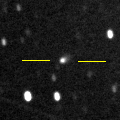
|
Now it is 15.2 mag (Jan. 6, ATLAS South Africa). It is expected to brighten up to 7 mag in early 2024. In the Southern Hemisphere, it stays observable in good condition for a long time. It locates low in the Northern Hemisphere.
Date(TT) R.A. (2000) Decl. Delta r Elong. m1 Best Time(A, h)
Jan. 14 5 32.35 -38 25.4 4.486 4.955 113 15.2 21:57 ( 0, 17)
Jan. 21 5 27.37 -38 6.4 4.458 4.889 110 15.1 21:25 ( 0, 17)
|
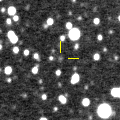
|
Now it is 15.7 mag (Dec. 31, iTelescope Observatory, Siding Spring). It will brighten up to 13 mag from 2024 to 2025. It is observable in excllent condition in the Southern Hemisphere. It locates low in the Northern Hemisphere.
Date(TT) R.A. (2000) Decl. Delta r Elong. m1 Best Time(A, h)
Jan. 14 9 8.03 -39 9.1 6.238 6.728 116 15.2 1:37 ( 0, 16)
Jan. 21 9 5.44 -39 22.6 6.159 6.694 119 15.2 1:07 ( 0, 16)
|
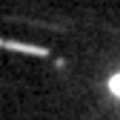
|
Now it is 16.1 mag (Jan. 12, Catalina Sky Survey). It will brighten rapidly up to 14 mag and will be observable in excellent condition in spring. In the Northern Hemisphere, it is observable in good condition in winter, but it becomes somewhat low in spring.
Date(TT) R.A. (2000) Decl. Delta r Elong. m1 Best Time(A, h)
Jan. 14 14 1.52 -8 44.5 2.339 2.406 81 15.4 5:38 (342, 45)
Jan. 21 14 9.02 -10 15.7 2.242 2.397 86 15.2 5:37 (349, 44)
|
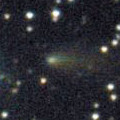
|
Now it is 14.4 mag (Dec. 27, Ken-ichi Kadota). It will be fading after this, and it will be fainter than 18 mag in spring. It is observable in good condition in the Northern Hemisphere. It locates somewhat low in the Southern Hemisphere.
Date(TT) R.A. (2000) Decl. Delta r Elong. m1 Best Time(A, h)
Jan. 14 7 47.41 23 10.1 1.577 2.560 177 15.3 0:17 ( 0, 78)
Jan. 21 7 41.76 23 46.4 1.600 2.579 172 15.4 23:39 ( 0, 79)
|

|
Appearing in the morning sky. Now it is 16.0 mag (Jan. 7, Ken-ichi Kadota). It will brighten very rapidly. It is expected to be observable at 11 mag in excellent condition from spring to summer.
Date(TT) R.A. (2000) Decl. Delta r Elong. m1 Best Time(A, h)
Jan. 14 16 3.50 -25 4.8 2.708 2.202 49 15.9 5:38 (319, 17)
Jan. 21 16 19.57 -25 22.8 2.624 2.180 53 15.5 5:37 (322, 18)
|

|
Now it is 15.5 mag (Jan. 13, ATLAS Chile). It was expected to brighten up to 13 mag in 2022 spring. But actually, it was fainter than originally expected. In the Southern Hemisphere, it stays observable in good condition for a long time. In the Northern Hemisphere, it stays extremely low for a while.
Date(TT) R.A. (2000) Decl. Delta r Elong. m1 Best Time(A, h)
Jan. 14 2 20.88 -36 10.2 3.672 3.721 85 15.7 18:47 ( 0, 19)
Jan. 21 2 17.09 -33 42.9 3.793 3.757 80 15.8 18:45 ( 7, 21)
|
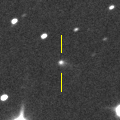
|
Now it is 15.2 mag (Jan. 13, ATLAS-HKO, Haleakala). It stays 15-16 mag and observable in good condition until spring.
Date(TT) R.A. (2000) Decl. Delta r Elong. m1 Best Time(A, h)
Jan. 14 9 36.34 21 51.3 2.472 3.379 153 15.8 2:05 ( 0, 77)
Jan. 21 9 35.08 22 51.3 2.433 3.374 160 15.7 1:37 ( 0, 78)
|
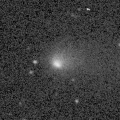
|
It brightened up to 14.6 mag in autumn (Oct. 19, Toshihiko Ikemura, Hirohisa Sato). Now it is fading. It has already faded down to 17.7 mag (Dec. 26, A. Diepvens). It will be fainter than 18 mag in spring.
Date(TT) R.A. (2000) Decl. Delta r Elong. m1 Best Time(A, h)
Jan. 14 1 55.38 4 42.2 1.898 2.216 95 15.9 18:39 ( 8, 60)
Jan. 21 2 4.46 5 44.4 1.992 2.231 90 16.1 18:45 ( 20, 59)
|
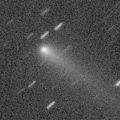
|
It brightened up to 14.1 mag in autumn (Nov. 14, Thomas Lehmann). Now it is fading. It has already faded down to 15.5 mag (Jan. 4, Ken-ichi Kadota). It stays observable in excellent condition for a while.
Date(TT) R.A. (2000) Decl. Delta r Elong. m1 Best Time(A, h)
Jan. 14 2 10.88 29 9.9 2.044 2.509 106 16.0 18:39 ( 2, 84)
Jan. 21 2 17.24 29 51.6 2.141 2.526 101 16.2 18:45 ( 52, 82)
|
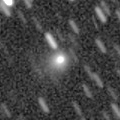
|
It brightened by 6 mag in outburst in early August up to 14.6 mag (Aug. 13, ATLAS-MLO, Mauna Loa). It has already faded down to 16.7 mag (Dec. 25, Catalina Sky Survey). It will be extremely low after this.
Date(TT) R.A. (2000) Decl. Delta r Elong. m1 Best Time(A, h)
Jan. 14 22 46.62 -7 32.9 2.233 1.719 46 16.1 18:39 ( 59, 26)
Jan. 21 23 5.80 -6 55.8 2.279 1.722 44 16.1 18:45 ( 62, 24)
|
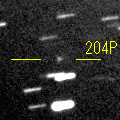
|
It brightened rapidly. Now it is 16.6 mag (Jan. 13, ATLAS-HKO, Haleakala). It is observable at 16 mag in good condition in winter.
Date(TT) R.A. (2000) Decl. Delta r Elong. m1 Best Time(A, h)
Jan. 14 10 18.77 15 49.8 1.030 1.905 142 16.2 2:48 ( 0, 71)
Jan. 21 10 18.40 16 41.5 1.008 1.922 149 16.1 2:20 ( 0, 72)
|
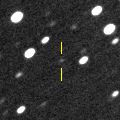
|
Now it is 16.0 mag (Jan. 10, ATLAS Chile). It is expected to brighten up to 12-13 mag from 2024 to 2025.
Date(TT) R.A. (2000) Decl. Delta r Elong. m1 Best Time(A, h)
Jan. 14 10 15.49 -19 40.4 5.716 6.319 124 16.3 2:44 ( 0, 35)
Jan. 21 10 10.38 -19 19.6 5.588 6.276 130 16.2 2:12 ( 0, 36)
|

|
It was observed at 15 mag from 2021 to 2022. Now it is fading. In the Southern Hemisphere, it stays observable in excellent condition for a long time. In the Northern Hemiphere, it is not observable after this.
Date(TT) R.A. (2000) Decl. Delta r Elong. m1 Best Time(A, h)
Jan. 14 15 18.85 -61 41.1 6.427 5.990 59 16.3 5:38 (345,-10)
Jan. 21 15 19.40 -62 54.0 6.379 6.019 64 16.3 5:37 (348,-10)
|
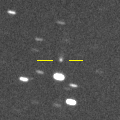
|
It will brighten up to 16 mag in 2023. In the Southern Hemisphere, it stays observable in good condition for a long time. In the Northern Hemisphere, it will never be observable again.
Date(TT) R.A. (2000) Decl. Delta r Elong. m1 Best Time(A, h)
Jan. 14 15 8.06 -63 46.7 3.610 3.253 61 16.4 5:38 (347,-12)
Jan. 21 15 29.17 -65 30.5 3.563 3.248 63 16.4 5:37 (348,-13)
|
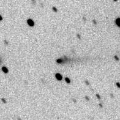
|
Now it is 16.5 mag (Dec. 31, ATLAS South Africa). It is observable at 16-17 mag in excellent condition from autumn to winter.
Date(TT) R.A. (2000) Decl. Delta r Elong. m1 Best Time(A, h)
Jan. 14 4 0.69 -1 0.6 2.880 3.501 121 16.4 20:27 ( 0, 54)
Jan. 21 4 0.80 -0 35.7 2.966 3.506 115 16.5 19:59 ( 0, 54)
|
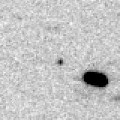
|
Now it is 16.6 mag (Jan. 13, ATLAS South Africa). It stays observable at 16 mag for a long time from early 2023 to early 2024. In the Northern Hemisphere, it is observable only until 2023 spring.
Date(TT) R.A. (2000) Decl. Delta r Elong. m1 Best Time(A, h)
Jan. 14 10 8.26 -1 9.5 3.567 4.342 137 16.6 2:37 ( 0, 54)
Jan. 21 10 0.67 -2 3.1 3.468 4.311 145 16.5 2:02 ( 0, 53)
|
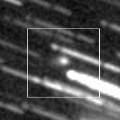
|
Now it is 17.2 mag (Dec. 12, D. Buczynski). It is expected to brighten up to 11.5 mag in 2024 spring. It stays observable in good condition for a long time. At the high light, it will be observable in excellent condition in the Southern Hemisphere, but it will be low in the Northern Hemisphere.
Date(TT) R.A. (2000) Decl. Delta r Elong. m1 Best Time(A, h)
Jan. 14 18 23.16 14 29.0 5.641 4.936 40 16.7 5:38 (264, 18)
Jan. 21 18 26.01 14 28.1 5.558 4.885 42 16.6 5:37 (268, 23)
|
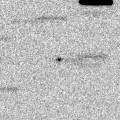
|
Now it is 17.0 mag (Jan. 7, Ken-ichi Kadota). It brightens rapidly, and it is observable at 16.5 mag in good condition from January to March.
Date(TT) R.A. (2000) Decl. Delta r Elong. m1 Best Time(A, h)
Jan. 14 11 11.42 20 7.3 0.364 1.252 130 16.9 3:39 ( 0, 75)
Jan. 21 11 40.29 22 17.4 0.349 1.242 131 16.7 3:41 ( 0, 77)
|
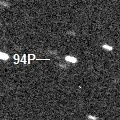
|
Now it is 17.5 mag (Jan. 13, ATLAS-HKO, Haleakala). It brightens rapidly, and it is observable at 16.5 mag in good condition in spring. It locates somewhat low in the Southern Hemisphere.
Date(TT) R.A. (2000) Decl. Delta r Elong. m1 Best Time(A, h)
Jan. 14 8 45.09 26 20.2 1.429 2.391 164 17.0 1:15 ( 0, 81)
Jan. 21 8 39.94 27 1.3 1.399 2.375 170 16.9 0:42 ( 0, 82)
|
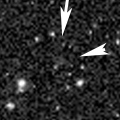
|
Now it is 16.4 mag (Jan. 1, iTelescope Observatory, Siding Spring). Very far object. It stays 16-17 mag for a long time from 2021 to 2026. In the Southern Hemisphere, it stays observable in good condition for a long time. In the Northern Hemisphere, it is not observable at all.
Date(TT) R.A. (2000) Decl. Delta r Elong. m1 Best Time(A, h)
Jan. 14 6 19.04 -76 31.5 10.546 10.441 81 16.9 22:41 ( 0,-22)
Jan. 21 6 3.98 -76 20.4 10.532 10.436 81 16.9 21:59 ( 0,-21)
|
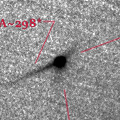
|
Due to the DART spacecraft impact to its satellite Dimorphos on Sept. 26, the cometary activity was detected. It brightened up to 12.9 mag (Sept. 28, John Drummond). It has already returned to its original brightness. It stays observable in good condition for a while.
Date(TT) R.A. (2000) Decl. Delta r Elong. m1 Best Time(A, h)
Jan. 14 7 24.15 30 41.4 0.330 1.310 170 17.0 23:49 ( 0, 86)
Jan. 21 7 16.77 30 50.7 0.375 1.348 163 17.5 23:14 ( 0, 86)
|
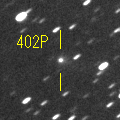
|
It brightened up to 15.3 mag in last winter (Jan. 12, 2022, H. Nohara). Now it is fading. It has already faded down to 17.0 mag (Jan. 2, Purple Mountain Observatory, XuYi Station). It will be observable at 17 mag in good condition in next winter. It locates low in the Southern Hemisphere.
Date(TT) R.A. (2000) Decl. Delta r Elong. m1 Best Time(A, h)
Jan. 14 10 23.92 24 3.0 3.695 4.514 142 17.0 2:53 ( 0, 79)
Jan. 21 10 21.84 24 58.2 3.658 4.532 149 17.0 2:23 ( 0, 80)
|

|
It brightened very rapidly up to 15.5 mag from last autumn to last winter (Nov. 2, 2021, Toshihiko Ikemura, Hirohisa Sato). Now it is fading slowly. It has already faded down to 16.8 mag (Jan. 11, ATLAS Chile).
Date(TT) R.A. (2000) Decl. Delta r Elong. m1 Best Time(A, h)
Jan. 14 6 20.25 9 24.1 3.590 4.514 157 17.1 22:46 ( 0, 64)
Jan. 21 6 17.04 9 28.6 3.650 4.534 150 17.1 22:15 ( 0, 64)
|

|
Now it is 16.5 mag (Jan. 1, ATLAS Chile). It brightened up to 14 mag from 2020 to 2021. Now it is fading slowly.
Date(TT) R.A. (2000) Decl. Delta r Elong. m1 Best Time(A, h)
Jan. 14 0 21.37 -12 41.8 4.512 4.230 67 17.1 18:39 ( 34, 36)
Jan. 21 0 25.94 -11 48.2 4.623 4.246 61 17.2 18:45 ( 42, 33)
|
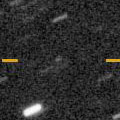
|
Appearing in the morning sky. It stays observable at 14-15 mag from spring to autumn. It locates somewhat low in the Northern Hemisphere.
Date(TT) R.A. (2000) Decl. Delta r Elong. m1 Best Time(A, h)
Jan. 14 16 48.60 -10 50.1 3.907 3.249 42 17.3 5:38 (301, 21)
Jan. 21 16 58.28 -11 20.6 3.821 3.228 46 17.1 5:37 (304, 23)
|
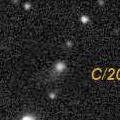
|
Now it is 17.1 mag (Jan. 3, ATLAS Chile). It stays 17 mag and observable in good condition for a long time until 2023 summer.
Date(TT) R.A. (2000) Decl. Delta r Elong. m1 Best Time(A, h)
Jan. 14 13 34.49 5 15.2 8.770 8.880 93 17.2 5:38 (348, 60)
Jan. 21 13 33.15 5 40.4 8.651 8.885 100 17.2 5:34 ( 0, 61)
|
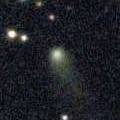
|
Now it is 17.1 mag (Dec. 14, A. Diepvens). Fading slowly. In the Southern Hemisphere, it is not observable after this.
Date(TT) R.A. (2000) Decl. Delta r Elong. m1 Best Time(A, h)
Jan. 14 17 42.66 41 47.6 6.235 5.951 68 17.2 5:38 (241, 38)
Jan. 21 17 50.28 42 39.9 6.238 5.983 70 17.2 5:37 (241, 41)
|
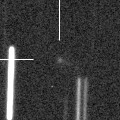
|
Now it is 17.3 mag (Jan. 11, Ken-ichi Kadota). It will brighten up to 13 mag in summer. In the Northern Hemisphere, it stays observable in good condition for a long time. In the Southern Hemisphere, it is not observable until August.
Date(TT) R.A. (2000) Decl. Delta r Elong. m1 Best Time(A, h)
Jan. 14 10 34.11 59 33.1 1.816 2.571 131 17.4 3:04 (180, 66)
Jan. 21 10 20.97 64 56.5 1.749 2.500 130 17.2 2:23 (180, 60)
|
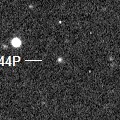
|
Now it is 17.5 mag (Jan. 12, J. V. Martinez). It is observable at 17 mag in good condition in winter. It locates somewhat low in the Southern Hemisphere.
Date(TT) R.A. (2000) Decl. Delta r Elong. m1 Best Time(A, h)
Jan. 14 5 56.84 26 19.9 3.008 3.927 155 17.3 22:22 ( 0, 81)
Jan. 21 5 53.29 26 16.1 3.059 3.928 148 17.3 21:51 ( 0, 81)
|

|
Now it is 17.1 mag (Jan. 9, D. Buczynski). Fading slowly. In the Northern Hemisphere, it stays observable in good condition for a long time. In the Southern Hemisphere, it is not observable after this.
Date(TT) R.A. (2000) Decl. Delta r Elong. m1 Best Time(A, h)
Jan. 14 18 4.23 64 42.5 9.623 9.641 88 17.3 5:38 (211, 38)
Jan. 21 18 9.02 65 17.8 9.634 9.657 88 17.3 5:37 (211, 41)
|
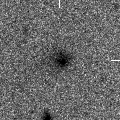
|
Now it is 17.4 mag (Jan. 9, ATLAS South Africa). Very large comet. It is expected to brighten up to 14 mag in 2031. In the Southern Hemisphere, it stays observable in good condition for a long time. In the Northern Hemisphere, it is not observable until 2030.
Date(TT) R.A. (2000) Decl. Delta r Elong. m1 Best Time(A, h)
Jan. 14 2 27.82 -60 18.8 18.296 18.102 77 17.4 18:53 ( 0, -5)
Jan. 21 2 27.55 -60 2.6 18.310 18.077 74 17.4 18:45 ( 2, -5)
|

|
Now it is 17.7 mag (Jan. 7, W. Hasubick). It stays 17 mag for a long time from 2023 to 2024. It is observable in good condition in the Northern Hemisphere. It locates low in the Southern Hemisphere.
Date(TT) R.A. (2000) Decl. Delta r Elong. m1 Best Time(A, h)
Jan. 14 2 20.67 27 54.7 6.699 7.071 108 17.6 18:47 ( 0, 83)
Jan. 21 2 21.70 27 53.3 6.792 7.057 101 17.6 18:45 ( 38, 81)
|

|
It brightened up to 14 mag in 2021. Now it is fading. It has already faded down to 17.4 mag (Jan. 7, W. Hasubick). It will be fainter than 18 mag in March. It is already unobservable in the Southern Hemisphere.
Date(TT) R.A. (2000) Decl. Delta r Elong. m1 Best Time(A, h)
Jan. 14 23 25.03 16 18.5 7.104 6.777 66 17.6 18:39 ( 74, 48)
Jan. 21 23 27.77 16 40.3 7.241 6.816 60 17.6 18:45 ( 81, 42)
|
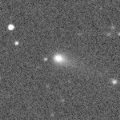
|
Now it is 17.9 mag (Dec. 25, Catalina Sky Survey). It continued brightening even after the perihelion passage. It will be fading after this, and it will be fainter than 18 mag in February.
Date(TT) R.A. (2000) Decl. Delta r Elong. m1 Best Time(A, h)
Jan. 14 23 29.98 -1 8.1 4.927 4.508 59 17.6 18:39 ( 55, 38)
Jan. 21 23 35.65 -0 35.8 5.033 4.522 53 17.7 18:45 ( 62, 33)
|

|
Now it is 17.8 mag (Dec. 26, Ken-ichi Kadota). It is observable at 17.5 mag in good condition in winter.
Date(TT) R.A. (2000) Decl. Delta r Elong. m1 Best Time(A, h)
Jan. 14 8 58.13 -0 20.8 2.604 3.497 151 17.7 1:27 ( 0, 55)
Jan. 21 8 54.96 -0 25.1 2.571 3.497 156 17.7 0:57 ( 0, 54)
|
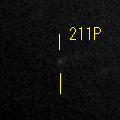
|
Now it is 18.1 mag (Dec. 30, Ken-ichi Kadota). It brightens up to 17.5 mag from January to February. It locates somewhat low in the Southern Hemisphere.
Date(TT) R.A. (2000) Decl. Delta r Elong. m1 Best Time(A, h)
Jan. 14 11 57.16 16 44.6 1.779 2.420 119 17.7 4:26 ( 0, 72)
Jan. 21 12 0.62 17 52.5 1.723 2.433 125 17.7 4:02 ( 0, 73)
|
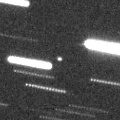
|
Now it is 17.0 mag (Nov. 26, Toshihiko Ikemura, Hirohisa Sato). It will be fading after this.
Date(TT) R.A. (2000) Decl. Delta r Elong. m1 Best Time(A, h)
Jan. 14 7 10.54 20 13.7 0.972 1.952 172 17.7 23:35 ( 0, 75)
Jan. 21 7 1.21 20 22.8 1.046 2.010 163 18.2 22:59 ( 0, 75)
|
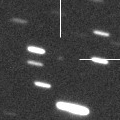
|
Now it is 17.4 mag (Dec. 29, D. Wilde). It stays 17.5 mag until spring. It is observable in good condition in the Northern Hemisphere. It is not observable in the Southern Hemisphere.
Date(TT) R.A. (2000) Decl. Delta r Elong. m1 Best Time(A, h)
Jan. 14 21 25.53 79 24.5 2.813 3.166 101 17.8 18:39 (167, 38)
Jan. 21 22 12.36 79 59.5 2.810 3.155 101 17.7 18:45 (168, 38)
|
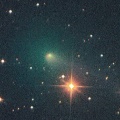
|
It brightened up to 11.1 mag in 2022 spring (May 21, Thomas Lehmann). Now it is fading. It has already faded down to 18.1 mag (Dec. 6, iTelescope Observatory, Siding Spring).
Date(TT) R.A. (2000) Decl. Delta r Elong. m1 Best Time(A, h)
Jan. 14 1 9.72 2 12.0 2.971 3.026 83 17.8 18:39 ( 27, 54)
Jan. 21 1 15.71 2 59.3 3.109 3.065 78 18.0 18:45 ( 38, 52)
|
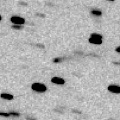
|
Now it is 17.9 mag (Dec. 27, Ken-ichi Kadota). In the Northern Hemisphere, it stays observable at 17 mag in good condition for a long time until winter. In the Southern Hemisphere, it stays extremely low for a long time.
Date(TT) R.A. (2000) Decl. Delta r Elong. m1 Best Time(A, h)
Jan. 14 7 54.66 50 43.3 2.288 3.182 150 17.8 0:25 (180, 74)
Jan. 21 7 48.76 50 15.9 2.330 3.217 149 17.9 23:47 (180, 75)
|
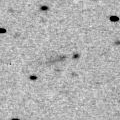
|
Now it is 18.4 mag (Dec. 18, Ken-ichi Kadota). It stays observable at 18 mag in good condition from January to March.
Date(TT) R.A. (2000) Decl. Delta r Elong. m1 Best Time(A, h)
Jan. 14 10 34.89 12 15.8 3.439 4.215 137 17.9 3:04 ( 0, 67)
Jan. 21 10 33.53 12 35.7 3.367 4.210 144 17.9 2:35 ( 0, 67)
|

|
It brightened up to 14.2 mag in 2021 summer (July 18, 2021, Taras Prystavski). Now it is fading. It has already faded down to 17.3 mag (Dec. 22, ATLAS South Africa). In the Southern Hemisphere, it stays observable in good condition for a long time. It locates somewhat low in the Northern Hemisphere.
Date(TT) R.A. (2000) Decl. Delta r Elong. m1 Best Time(A, h)
Jan. 14 1 15.27 -17 7.6 6.192 6.068 78 17.9 18:39 ( 17, 36)
Jan. 21 1 16.63 -16 8.8 6.339 6.112 72 18.0 18:45 ( 26, 35)
|

|
It has not been observed yet in this apparition. In the last apparition, it had faded before the perihelion passage. If it becomes as bright as its last apparition, it will brighten up to 17 mag. It stays observable in good condition for a long time.
Date(TT) R.A. (2000) Decl. Delta r Elong. m1 Best Time(A, h)
Jan. 14 13 43.56 -0 1.9 2.811 2.966 89 18.0 5:38 (346, 54)
Jan. 21 13 50.35 -0 5.7 2.698 2.946 94 17.9 5:37 (354, 55)
|

|
It brightened up to 12.3 mag from spring to summer in 2021 (June 15, 2021, Marco Goiato). Now it is fading. It has already faded down to 17.7 mag (Jan. 2, J. Jahn). It will be fainter than 18 mag in January.
Date(TT) R.A. (2000) Decl. Delta r Elong. m1 Best Time(A, h)
Jan. 14 12 38.63 38 4.2 5.983 6.458 114 17.9 5:07 (180, 87)
Jan. 21 12 35.26 39 17.4 5.947 6.504 120 17.9 4:36 (180, 86)
|
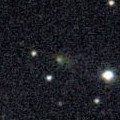
|
Now it is 17.6 mag (Dec. 26, A. Diepvens). It will be fading after this, and it will be fainter than 18 mag in January.
Date(TT) R.A. (2000) Decl. Delta r Elong. m1 Best Time(A, h)
Jan. 14 2 58.09 21 49.3 2.287 2.846 115 17.9 19:25 ( 0, 77)
Jan. 21 3 1.74 21 44.0 2.404 2.876 108 18.1 19:01 ( 0, 77)
|
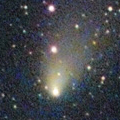
|
It brightened up to 10.4 mag from June to July (July 22, Ken-ichi Kadota). Now it is fading. Appearing in the morning sky in the Souther Hemisphere. It was originally predicted as 15 mag now. But actually, now it is very faint as 18.4 mag (Jan. 2, Martin Masek). It will never be observable again in the Northern Hemisphere.
Date(TT) R.A. (2000) Decl. Delta r Elong. m1 Best Time(A, h)
Jan. 14 19 7.20 -64 58.5 3.294 2.674 43 18.6 5:38 (330,-31)
Jan. 21 19 35.20 -64 46.3 3.359 2.754 45 18.9 5:37 (330,-31)
|
|
![]()
 C/2020 Y2 ( ATLAS )
C/2020 Y2 ( ATLAS ) C/2020 S4 ( PanSTARRS )
C/2020 S4 ( PanSTARRS ) 61P/Shajn-Schaldach
61P/Shajn-Schaldach P/2022 L3 ( ATLAS )
P/2022 L3 ( ATLAS ) 285P/LINEAR
285P/LINEAR 204P/LINEAR-NEAT
204P/LINEAR-NEAT C/2022 E2 ( ATLAS )
C/2022 E2 ( ATLAS ) C/2018 U1 ( Lemmon )
C/2018 U1 ( Lemmon ) C/2021 C5 ( PanSTARRS )
C/2021 C5 ( PanSTARRS ) 408P/2020 M7 ( Novichonok-Gerke )
408P/2020 M7 ( Novichonok-Gerke ) C/2022 A3 ( Lemmon-ATLAS )
C/2022 A3 ( Lemmon-ATLAS ) C/2022 L2 ( ATLAS )
C/2022 L2 ( ATLAS ) 263P/Gibbs
263P/Gibbs 94P/Russell 4
94P/Russell 4 C/2019 E3 ( ATLAS )
C/2019 E3 ( ATLAS ) (65803) Didymos
(65803) Didymos 402P/2020 Q3 ( LINEAR )
402P/2020 Q3 ( LINEAR ) P/2021 N2 ( Fuls )
P/2021 N2 ( Fuls ) 246P/NEAT
246P/NEAT 199P/Shoemaker 4
199P/Shoemaker 4 C/2020 F2 ( ATLAS )
C/2020 F2 ( ATLAS ) C/2020 H6 ( ATLAS )
C/2020 H6 ( ATLAS ) C/2022 W3 ( Leonard )
C/2022 W3 ( Leonard ) 244P/Scotti
244P/Scotti C/2019 O3 ( Palomar )
C/2019 O3 ( Palomar ) C/2014 UN271 ( Bernardinelli-Bernstein )
C/2014 UN271 ( Bernardinelli-Bernstein ) C/2021 S4 ( Tsuchinshan )
C/2021 S4 ( Tsuchinshan ) C/2020 F5 ( MASTER )
C/2020 F5 ( MASTER ) 395P/2020 H1 ( Catalina-NEAT )
395P/2020 H1 ( Catalina-NEAT ) P/2021 V2 ( Fuls )
P/2021 V2 ( Fuls ) 211P/Hill
211P/Hill 107P/(4015) Wilson-Harrington
107P/(4015) Wilson-Harrington C/2022 W2 ( ATLAS )
C/2022 W2 ( ATLAS ) 22P/Kopff
22P/Kopff C/2021 QM45 ( PanSTARRS )
C/2021 QM45 ( PanSTARRS ) 452P/2022 B5 ( Sheppard-Jewitt )
452P/2022 B5 ( Sheppard-Jewitt ) C/2019 F1 ( ATLAS-Africano )
C/2019 F1 ( ATLAS-Africano ) 280P/Larsen
280P/Larsen C/2020 J1 ( SONEAR )
C/2020 J1 ( SONEAR ) 44P/Reinmuth 2
44P/Reinmuth 2 C/2021 P4 ( ATLAS )
C/2021 P4 ( ATLAS )![]()

































































